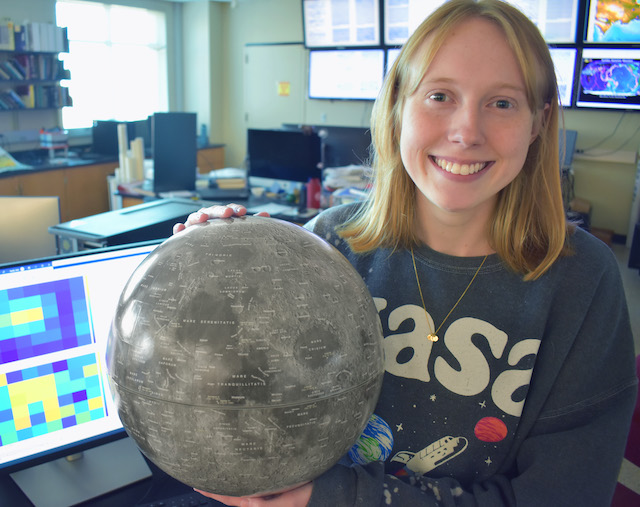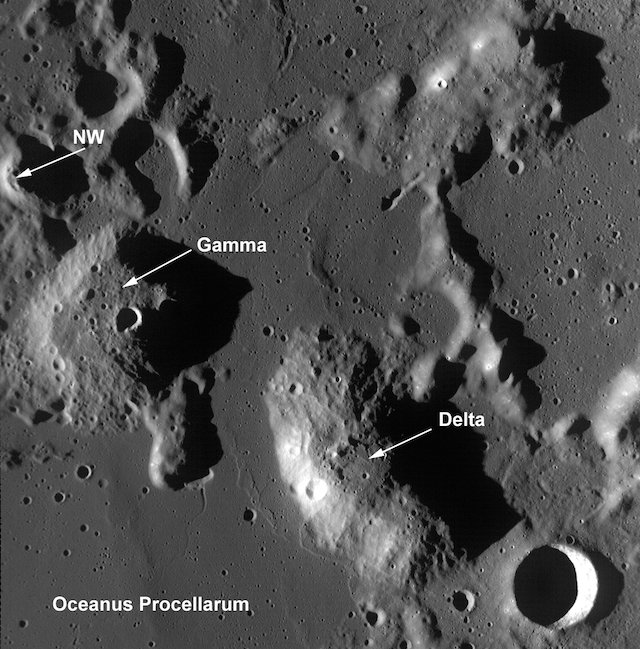Baylor Planetary Research Group Earns NASA Grant to Study Density of the Moon's 'Weird' Volcanoes


With the funding, Baylor sophomore Allie North leads effort to understand these mysterious silicic volcanoes on the surface of the Moon
Media Contact: Shelby Cefaratti-Bertin, Baylor University Media and Public Relations, 254-327-8012
Follow us on Twitter: @BaylorUMedia
WACO, Texas (Jan. 9, 2023) – Silicic volcanoes on the Moon, specifically the mysterious Gruithuisen Domes, are a lunar geologic mystery that still perplexes scientists more than half a century after they were discovered. Based on early telescopic and spacecraft observations, these extinct volcanoes have long been suspected to be silicic in composition, in some ways similar to terrestrial strato volcanoes like Mount St. Helens in Washington state.
This phenomenon has created interesting questions for Baylor University's Peter B. James, Ph.D., assistant professor of planetary geophysics and founder of Baylor's Planetary Research Group (PRG), which specializes in the use of spacecraft-derived gravity fields to study the crusts and mantles of planets and moons in the solar system. With funding from a $260,000 grant provided by NASA's Lunar Data Analysis Program (LDAP), James and the student researchers in the PRG are studying the bulk density of the Moon's silicic volcanoes, which are comprised of a type of rock "that is a little bit weird."
Allie North, a sophomore Science Research Fellow at Baylor, is leading the effort to analyze the bulk density of five different volcanic areas around the Moon will add to the future of space exploration by understanding the density of Moon volcanoes, including the mysterious Gruithuisen Domes. This is especially timely since NASA recently announced, as part of its Artemis lunar exploration plans, it will send two new science instrument suites to the Moon in an upcoming commercial mission, including one that will land on the Gruithuisen Domes for the first time. North’s research will be instrumental in preparing for this and other missions by providing information on the density of the rock that makes up the formations, further expanding on theories of how they were created and identifying objectives for future human space exploration.
Weird volcanos on the Moon
“When we look up at the Moon, we see dark and light areas due to two primary rocks, basalt and anorthosite,” James said. “Dark areas are places made up of basalt rocks created through a series of flood-like volcanic eruptions across the history of the Moon.”
Magma erupted, James said, and spread out like an ocean, covering large parts of the Moon and creating darker areas similar to the volcanos and lava flows found in Hawaii. In contrast, the brighter areas are anorthosite, an even older kind of rock that comprises the Moon’s primordial crust. However, the Gruithuisen domes are comprised of a third type of rock. Orbital remote sensing measurements indicate that several volcanoes on the Moon may be silicic, i.e., enriched in silicon and oxygen relative to other volcanic rocks. The steep sides of the volcanic domes imply that they were made from relatively viscous lavas, making it harder for the lava to spread out and flow. These highly viscous lavas are more prone to explosively erupt, although none of the Moon’s volcanoes are currently active.
"There are places on the Moon where it looks like there are silicic volcanoes, but that's weird because on Earth these volcanoes usually erupt in conjunction with plate tectonics and subduction of wet oceanic rocks, such as the northwest coast of the United States," James said. “On the Moon, there is no water or plate tectonics or any of the settings that would normally make silicic lava. How, then, did the Moon’s silicic volcanoes get there? That is a very interesting question."
Understanding the difference in density or weight between these rocks is the basis of James' research grant. Basaltic volcanic rocks, such as the ones found in Hawaii and the ones that make all the dark places seen on the Moon, tend to be heavier versus the rock that comes from more explosive and taller volcanoes, which tend to be lighter.
"We hypothesize that if the core of the Gruithuisen domes is mostly made of this lighter material, we can go and measure the density with data from a NASA mission called the Gravity Recovery And Interior Laboratory (GRAIL). We can use data from that mission to test this theory that these rocks are much less dense than normal volcanic rocks on the Moon."
Grant benefits graduate, undergraduate researchers
The grant also supports Baylor graduate and undergraduate students and allows them to dedicate more time and opportunity to contribute to the research by allowing them to do science full-time.
Nick Wagner, a Ph.D. candidate in planetary geophysics, is working on this project as a part of his dissertation. Although his dissertation is focused on Mars, the opportunity to learn from this research directly lends to the overall understanding of processes like magma generation and volcanic formations through comparative planetology.
"Volcanoes happen in a lot of different places, but there are small little tweaks to planets that make them the way they are," Wagner said. "It's interesting to compare them to one another and say, "Hey, why does Mars have volcanoes two and a half times the height of Everest? Why does the Moon have these silicic volcanoes essentially? The Moon and Mars are great little playgrounds to sort of test ideas like that, in addition to Earth."
At the heart of the research effort, sophomore Allie North is writing a code in MATLAB (an abbreviation of "MATrix LABoratory") to analyze the gravity of the domes and compare it to the expected gravity of the topography. North is processing data from NASA's GRAIL mission, which measured the gravity field of the Moon. From the subtle increase in the strength of gravity above the volcanoes, she will be able to calculate the mass of the volcanoes.
"We know the volume of the volcanoes from a laser altimeter on NASA's Lunar Reconnaissance Orbiter (LRO), and density equals mass divided by volume, so Allie will synthesize data from both GRAIL and LRO to determine the average density of these volcanoes,” James said. “Silicic rocks have a lower density than basaltic rocks, and she will thereby test theories about the bulk composition of the volcanoes and their origins."
Allie will present the PRG’s analysis results for the Gruithuisen Domes at the Lunar and Planetary Science Conference in March 2023. She plans on continuing her education in graduate school and aims for a career in planetary geosciences.
This current Baylor research led by James strategically positions Baylor to be involved with future lunar science research. A subaward from the LDAP grant will allow the PRG to collaborate with Dr. Daniel Moriarty at NASA’s Goddard Space Flight Center, who is in expert in spacecraft remote sensing. The results of this project will enhance the value of data returned by the Lunar-VISE robotic lander, which will visit the Gruithuisen domes in 2026. Dr. James has also contributed to the Artemis Science Definition team to delineate priorities for future astronaut missions, and the LDAP research project may further influence future NASA’s decisions about human space exploration.
Lunar Data Analysis Program
NASA’s Lunar Data Analysis Program (LDAP) funds research on the analysis of data from lunar missions for lunar science investigations. The overall objectives of LDAP are to enhance the scientific return of lunar missions, broaden scientific participation in the analysis of lunar mission data sets and fund high-priority areas of research that support planning for future lunar missions. James' research adds to the future of space exploration by understanding the density of Moon volcanoes, which will lead directly to the future Artemis mission.
ABOUT PETER B. JAMES
Peter B. James, Ph.D., served on the science team of three NASA missions: the Lunar Reconnaissance Orbiter (LRO), the Gravity Recovery and Interior Laboratory (GRAIL), and the MErcury Surface, Space ENvironment, GEochemistry, and Ranging (MESSENGER) mission. He is the founder of Baylor University's Planetary Research Group, which is currently collaborating with Goddard Space Flight Center on multiple projects to study the Moon and the planet Mercury. Dr. James specializes in the use of spacecraft data to study the crusts and mantles of planets and moons in our solar system. He earned his Ph.D. from the Massachusetts Institute of Technology.
ABOUT BAYLOR UNIVERSITY
Baylor University is a private Christian University and a nationally ranked research institution. The University provides a vibrant campus community for more than 17,000 students by blending interdisciplinary research with an international reputation for educational excellence and a faculty commitment to teaching and scholarship. Chartered in 1845 by the Republic of Texas through the efforts of Baptist pioneers, Baylor is the oldest continually operating University in Texas. Located in Waco, Baylor welcomes students from all 50 states and more than 90 countries to study a broad range of degrees among its 12 nationally recognized academic divisions.
ABOUT THE COLLEGE OF ARTS & SCIENCES AT BAYLOR UNIVERSITY
The College of Arts & Sciences is Baylor University's oldest and largest academic division, consisting of 25 academic departments and seven academic centers and institutes. The more than 5,000 courses taught in the College span topics from art and theatre to religion, philosophy, sociology and the natural sciences. Faculty conduct research around the world, and research on the undergraduate and graduate level is prevalent throughout all disciplines. Visit www.baylor.edu/artsandsciences.